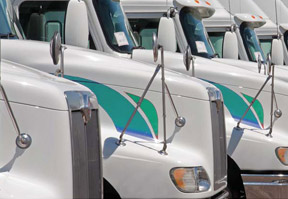Telit’s GE865-Quad GSM/GPRS module delivers fleet data to Mexico’s largest beverage distributor. Analysing the results facilitated the decision to restructure the delivery process. Mike Ueland explains how the value was uncovered.
The leading bottler and distributor of soft drinks in Mexico employs a fleet of more than 8,000 vehicles and operates in a highly competitive environment. In order to evaluate the efficiency of its nationwide distribution and process management systems, the company’s management decided to conduct a trial and feasibility study at its main distribution centres in Mexico City, Puebla and Veracruz. Tritavia, a company focused on the implementation and improvement of industrial and business processes, supplied its SIAF (Sistema Integral de Administración de Flotillas) fleet management system, which uses Telit’s GE865-Quad GSM/GPRS modules to deliver real-time data from the vehicles.
An initial three-month trial conducted to evaluate the system was based on a small fleet of 45 vehicles operating in three cities. After the trial, Tritavia analysed the data and found that focusing on six key process elements could potentially result in significant savings. Today, Tritavia is running the second phase of the project – using 400 vehicles in the same three cities to demonstrate real-world savings. The trial will be extended to 900 vehicles operating in additional cities by the end of this year.
Centralised versus decentralised distribution
Fleet management systems provide a wealth of real-time data on driving behaviour and vehicle performance, but management of this nationwide distributor had a specific requirement. It wanted the various data sets to be analysed to determine the respective cost of a centralised versus decentralised distribution model. This is a complex task, and for the trial, Tritavia decided to focus on collecting data on six process elements: (1) stops; (2) driving practices; (3) vehicle performance; (4) unauthorised stops; (5) refuelling and (6) frauds linked to refuelling. Of course, Tritavia’s platform is scalable to allow more elements to be added in future.
The initial results revealed ten areas where costs could be reduced (see panel ‘Opportunities for cost reduction’). In order to meet the management objective, the individual costs had to be applied to the two distribution models. If we keep things simple, but not too simple, it is clear that this involves various trade-offs. For example, the distributed model will require more trucks, but journey times will be shorter, so less fuel will be consumed. Moreover, being in closer proximity to clients brings marketing benefits. In addition, the lower operating costs have to be offset against the capital cost of setting up a new distribution centre.
The result of this big data analysis resulted in the decision to restructure the distribution and process management systems, specifically, to implement a decentralised model. The distributor now intends to demonstrate to upper management of other distribution centres how the solution enables comparisons to be made between planned delivery times and fuel consumption, and the real-world results, with the objective of having each distribution centre adopt Tritavia’s management solution.
Better planning: the next step
Having realized the cost benefits of Tritavia’s fleet management system, the distributor, decided to focus on delivery times and employ a third-party planning system that collects field data sent by GPS devices and compares the results to the plans.
The main issue that Tritavia found was that the system uses standard times for planning deliveries. They comprise a fixed time – the mean of time based on previous visits, and a variable time – which would typically depend on the number of cases/pallets, but if these times were not correct, such as if they were out of date, then the planning would be incorrect and schedules could be disrupted.
SIAF delivers a historical record of all the actual times for each delivery. Therefore Tritavia developed an automated interface that delivers the real-time position of all vehicles to the planning system every 21 seconds. In this way, accurate delivery times are always used when routes are planned, producing significant benefits. For example, one route was using a fixed time of six hours while SIAF recorded the much lower time of three hours. This is significant because it means that the vehicle could have done another delivery.
Integration between the two applications has been completed in Mexico City and is underway in Puebla and Veracruz. Tritavia’s own software platform provides a number of key operating indicators, including positioning in a Google Maps window, displays of geofences, as well as speed alerts, historical tracking, driver behaviour, actual daily mileage and fuel consumption.
In addition, the managers who supervise the operation of a group of vehicles, typically 20, get daily granular data on individual drivers. Integrating SIAF with the third-party system enables the supervisors to plan individual routes and to process changes or make corrections as needed. The granular data includes alerts that are activated when a vehicle has stopped for more than 180 minutes at a customer site, as well as when the vehicle has returned to the distribution centre.
Enhanced fleet management functionality

Solutions
It is worth emphasising that the solution delivers all the expected fleet management features: GPS location, tracking and security. The process elements that Tritavia has introduced are additions and the company estimates that every dollar invested in their enhanced solution will result in a five dollar cost saving. For a large fleet, the potential saving can be as high as $75,000 a month for a single distribution centre with around 120 vehicles.
While the primary objective of this rollout was to minimise operating expenses, the operational database that the solution creates and updates in real-time creates benefits in other areas. For example, SIAF informs supervisors on the real-time status of their schedules so they can make adjustments to achieve priority deliveries and avoid vehicles losing time at the distribution centre or at customer sites. Supervisors can even inform large retail outlets about the estimated time of arrival, allowing the customer to have their forklift trucks ready to unload the pallets, thereby realising a fast, efficient turnaround.
“The results from this pilot demonstrated, with hard data, just how much savings are possible from the detection of bad practices in the field, fraud, risk reduction, availability and errors in process planning,” said Fernando Corona, general manager of Tritavia. “Thanks to the reliability and functionality of the Telit GE865-QUAD GSM/GPRS module, and the success of the trial, we have an open invitation to present these results to all distribution centres at their annual forums, with the intent of implementing the tool in as many delivery vehicles as possible, turning it into a fundamental part of their distribution process.”
The integration of established vertical solutions into mainstream business processes is a development that has moved centre stage, as has the insights into those processes that are generated by analysing the data. Tritavia fleet management solution, SIAF, combines both developments and Telit is proud of its contribution. In addition, and it is a very significant addition, the company is committed to facilitating integration across the M2M board: it’s an important component of our ONE STOP. ONE SHOP. offer, which is helping our customers achieve their business efficiency and cost savings goals. The offer provides product, services and facilities to connect organisations to the Internet of Things (IoT), allowing them to wirelessly collect, process and respond to real-world data from connected devices, creating new efficiencies, revenue streams, as well as societal and personal benefits.










